10 The Evolution of Space Technology
Adam Bauer
10.1 Introduction
Keywords
- Astronautics – the science and technology of human space travel and exploration
- Astronomy – the branch of science which deals with celestial objects, space, and the physical universe as a whole
- Ballistic Missile – a missile with a high, arching trajectory, which is initially powered and guided but falls under gravity on to its target
- Combustion – the process of burning something
- Propulsion – the action of driving or pushing forward
- Scientific Revolution – name given to a period of drastic change in scientific thought that took place during the 16th and 17th centuries
- Space Race – the competition between nations regarding achievements in the field of space exploration
- Thrust – push (something or someone) suddenly or violently in the specified direction
Learning Objectives
Know your MARS- By the end of this chapter, students should be able to:
- Master the history of the rocket
- Acknowledge how a rocket works and how it is crucial to launches today
- Recognize leading scientists and developers who contributed to the evolution of the rocket
- Share your knowledge with others
The evolution of space technology has come a long way since Greek philosophers were first interested in astronomy and space in the 1600s. However, the foundations of spacecraft date back to the 11th century, when the Chinese developed the first known rocket. This rocket was very similar to what we know today as the firework, and it is the substructure for modern-day liquid propulsion rockets. Over 1000 years, the rocket has developed into spacecraft we are familiar with, and it has paved the way for future life outside planet Earth. Spacecraft has changed the age of exploration from land and sea to the unknown world of space. Spacecraft developed by each achievement because there was little research and history of space. Space exploration will become easier and obtainable as our technology advances, leading to life on another planet sooner than anticipated.
10.2 The Rocket
Key Takeaway
10.2.1 The First Rocket
The Chinese created the first rocket known to man in the 11th century, known as the “fire arrow.” The fire arrow was similar to a modern-day firework, and they worked the same way. The fire arrow was a paper tube filled with gunpowder that exploded when lit. These rockets were used in war, and they were presented to the Empress of China like a firework show. Moving into the 12th century, the Chinese further developed these rockets by attaching them to mounts, keeping the tube intact, and shooting a flame close to 30 paces. Even though the distance is not far, this early development of rockets sparked the revolution for making rockets with increased power for more distance (Jixing Pan).

“The Chinese Fire Arrow “ by 火龍經 is licensed under CC BY-SA 4.0
10.2.2 Current Rockets
Current rockets are like fireworks, but they work on a larger scale. In the early 20th century, Konstantin Tsiolkovsky pitched the idea of liquid propulsion rockets. Tsiolkovsky discovered that in order to reach higher altitudes with rockets, the power must come from a different source. Gunpowder was too weak, which limited the distance a rocket could go. Following his discovery, astronomers and scientists quickly got to work to create a liquid propulsion rocket that is still used today. In a liquid propulsion rocket, stored fuel and oxidizer are released into a combustion chamber, where they are mixed and burned. In return, this creates a large amount of exhaust, which is passed through a nozzle resulting in thrust (NASA). This thrust causes motion, lifting the rocket off the ground. The higher the amount of combustion, the further the rocket will go. The design of liquid rocket propulsion is still used today in all launches, and without its development, space would be far out of reach.

“Rocket Diagram” by Nicholas Beeson is licensed under CC BY-SA 3.0
10.3. History of Spacecraft
Key Takeaway
10.3.1 Origin and Early History of the Rocket
The idea of traveling to space dates back to the 1600s, when astronomer Galileo was the first to observe space through his telescope. However, the evolution of rockets has been around as early as the 10th century before Galileo’s discovery. In 1044, the Chinese published the first known evidence of gunpowder development, which led to the development of the rocket (Jixing Pan). These rockets did not have propulsion like modern fireworks, but this is where the rocket originated. Rockets did not have propulsion until the 12th century when the Chinese improved the gunpowder solution. Moving into the 16th century, the invention of the rocket was spreading across Europe and Asia. During this time, rockets were mainly used for warfare. It wasn’t till the 17th century Scientific Revolution that rockets became a part of science. Sir Issac Newton, a leading philosopher in the scientific revolution, created laws to explain the science behind rockets, including how they worked (NASA).
10.3.2 Liquid Propulsion Rockets
Going into the 20th century, Russian school teacher, Konstantin Tsiolkovsky, proposed that space exploration is possible with rockets and liquid propellants. His theory of using liquid fuels for greater distances of rockets sparked the revolution of astronautics. Following Tsiolkovsky’s theory, Robert Goddard began to conduct experiments to achieve higher altitudes with rockets. Goddard believed these high altitudes are only achievable with liquid propulsion rockets. In 1926 Goddard successfully launched the first liquid propulsion rocket. Goddard and his achievements paved the way for the evolution of rocket science.
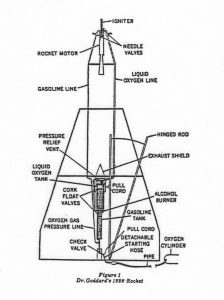
“Goddard’s First Liquid Propulsion” by NASA is in the Public Domain, CC0
10.3.3 Modern Rocketry
As the evolution of rockets quickly developed into modern spacecraft, countries began to compete for the top spot in astronautics. In 1957, the Soviet Union launched the first Earth-orbiting artificial satellite, known as Sputnik. This accomplishment shocked the world and marked the beginning of the Space Race between the Soviet Union and The United States. In 1958, the United States created the National Aeronautics and Space Administration space program, also known as N.A.S.A.
The National Aeronautics and Space Administration is a government agency that started in 1958. NASA is responsible for America’s civil space program and space research. NASA is the leading agency for space exploration and as of right now are leading the moon to Mars program in hopes of civilization on Mars. (NASA).
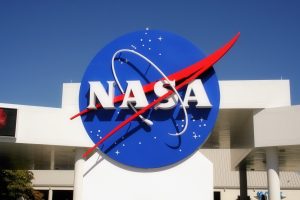
“NASA Logo “ by Tammy Sue is in the Public Domain, CC0
For years after the launch of Sputnik, both the Soviet Union and The United States worked on and improved satellites. The Soviets beat The United States in an unmanned space race, and then in 1961, they also launched the first human into space. Yuri Gagarin was the first human in space and the first human to orbit the Earth. Soon after Gargarin’s trip into space, the Soviet Union launched the first Space Station into space.
Yuri Gagarin explains in an interview how he felt after being the first man in space. He said, “I would like to praise here our Soviet designers, engineers and technicians, as well as the entire Soviet nation, for creating the remarkable spaceship “Vostok,” its remarkable equipment and powerful carrier rocket which has placed such a huge spaceship in orbit” (Gagarin, The Atlantic).

“Gagarin Goes to Space “ by Randy Macdonald is licensed under CC BY-NC-SA 2.0
In 1969, the United States launched Apollo 11. The spacecraft held three men, and they landed on the moon, making them the first astronauts to set foot on the moon. The landing on the moon was a monumental step in space exploration, and it opened the door to more efficient and safer human transportation to space. In 1965, the United States began to design and later opened a human transportation system for space, including a station and reusable parts (Burton Catledge and Jeremy Powell). The transportation and port were known as the Space Transportation System. The Space Transportation System had its first flight in 1981, and the last flight launched in 2011. The next breakthrough for the United States was opening the International Space Station, which was the most prominent space station to be launched into space. Since then, human transportation to space and space exploration has become more efficient and productive because of programs, space stations, and newer technology.
10.3.4 Space in the 21st Century
In the 21st century, space exploration hit its peak because of all the new technology invented. Human-crewed space flights were becoming more common, and The United States took over the Space Race after the fall of the Soviet Union. Countries worldwide began to focus more on space exploration and creating space centers for launching and studies. In the United States, the opening of the Kennedy Space Center was a huge milestone. Within the first decade of opening, the Kennedy Space Center ran 33 shuttles to space, and in 2000 they did 100 shuttle flights. Through the 2000s, exploration went beyond the moon and Earth, and space crafts began to orbit other planets, including Saturn, Mercury, dwarf planets, and even some asteroids. In 2002, a growing entrepreneur named Elon Musk launched the program called SpaceX. The goal of his program was to reduce costs of space transportation with the end goal of colonizing Mars. Over the years, SpaceX worked to develop reusable spacecraft, and in 2006 SpaceX started to work with NASA. SpaceX was responsible for creating commercial flights and reusable spacecraft for NASA. They also supplied astronauts on space stations with goods and supplies for study. SpaceX was a revolutionary turn in space exploration because of how the company was funded. SpaceX rapidly became a multi-billion dollar company because of investments from companies like Google and their entry into the stock market. In 2017, after over 100 launches in the company, SpaceX became the leading commercial launch provider. In 2020, SpaceX made history as it was the first private company to send humans into space. Following this, in September of 2021, SpaceX hit another massive milestone with an orbital launch of all private crew members. As of 2021, SpaceX is valued at nearly 101 billion dollars, and they are changing space exploration as we know it (Wikipedia).
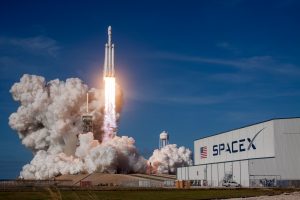
“FalconHeavy Test Launch “ by Official SpaceX Photos is licensed under CC BY-NC 2.0
10.4 The Impact of Rocket Technology
Key Takeaway
10.4.1 Pros of Rockets
Rockets are necessary for the exploration of space and possible life on another planet. With unknown knowledge of what is beyond our world, it is essential to have rockets so humans can discover and learn new things about our solar system and planet Earth. As our population of Earth grows rapidly every day, soon there will not be enough habitable space at the current rate of carbon dioxide output. In the future, rockets will be a crucial factor in expanding human life when room is unavailable. SpaceX, a leading aerospace company, has taken this idea to a new level. SpaceX is currently working with NASA and private investors to colonize the planet Mars in the near future.
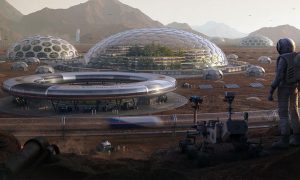
“Life on Mars “ by Spongy101010 is licensed under CC BY-SA 4.0
10.4.2 Cons of Rockets
Rockets were first developed as a new warfare technology during the 11th century in China. Over the decades, rockets were a primary use in warfare around the world. For example, the British used rockets in The War of 1812, and the potential of these rockets was very unclear. In the 1900s, the rocket quickly developed, and it was used in World War II as a ballistic missile. Following this, it became very common for military programs to have rockets ready for launch. Even though the ballistic missile paved the way for rocketships, they were used and are still used today as a weapon resulting in thousands of lives.
The biggest problem with rockets is not warfare but construction. All rockets are made of flammable material, whether it is gunpowder in the early ages or liquid propulsion now. Using unstable chemicals makes rockets extremely unsafe to build because they are so explosive. Early philosophers and scientists today still face these problems that can be deadly.
Today, spaceships are not only vulnerable to explosions, but they are also too reliant on technology. Technology is a crucial part of spacecraft evolution; however, technology can always malfunction. These malfunctions have been and still are leading factors to deaths associated with the space industry.
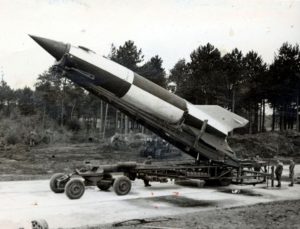
“The German V2 Ballistic Missile “ by Carlos Moreno Rekondo is licensed under CC BY-SA 4.0
10.5 – Future Outlook
Key Takeaway
10.5.1 Commercial Spacecrafts
The next significant milestone for space evolution will be commercial flights to outer space. Many competitors are racing in 2021 to be the first with commercial flights to space. Tourism is one of the highest economic factors right now, and space tourism would open tremendous economic opportunities (Webber). Not only would space tourism be an economic opportunity, but it would advance space exploration as we know it. If they were to use reusable spacecraft, it would save money, make space travel as a whole less risky, improve space exploration and improve the tourism industry.
10.5.2 Civilization in Space
After the invention and success of commercial spacecraft, civilizations in space could soon follow. Earth’s population is multiplying, and soon there will not be anywhere to expand. If life on Mars or another planet could be possible, overpopulation could be prevented. Civilization in space would also increase research of outer space, resulting in scientific and economic growth. Elon Musk at SpaceX is making this possible with the development of commercial flights and the end goal of human civilization on Mars.
Case Study: SpaceX has Started a New Age of Exploration
In the last ten years, Elon Musk has become a celebrity with the founding of Tesla and, specifically, SpaceX. Elon Musk launched the company SpaceX in 2002 to change the space industry and put humans on Mars. Over his ten years, Musk has faced many financial difficulties, going bankrupt close to three times. But, after signing contracts with NASA, Musk got SpaceX financially back on its feet and has slowly achieved the impossible. SpaceX was the first private company to send civilians to space in late 2021. SpaceX has been developing and testing the Starship; a spaceship meant to transport goods and people to Mars. In an interview with NBC in April of 2021, Musk “[r]emains “highly confident” that SpaceX will land humans on Mars by 2026” (NBC).
Chapter Summary
Space has always been of interest since the discovery of stars and planets. When the first rocket was invented, the intentions were for display and warfare. However, rockets were used to develop spacecraft that initiated space exploration. It took close to 100 years to build the modern spacecraft, but the doors to the future of space exploration are now opening. After putting a man on the moon and developing a station where people can live in space, the next achievement for humanity is life on Mars. As technology quickly advances, the next 20 years will be full of new accomplishments in the space industry.
Review Questions
1. What country created the first rocket that is similar to a modern day rocket?
A. The Soviet Union
B. United States
C. Germany
D. China
2. Who developed the first liquid propulsion rocket?
A. Issac Newton
B. Konstantin Tsiolkovsky
C. Robert Goddard
D. Elon Musk
3. Who developed the theory for liquid propulsion rockets?
A. Issac Newton
B. Konstantin Tsiolkovsky
C. Robert Goddard
D. Elon Musk
4. Do you remember your MARS? What were the goals for this chapter? (Circle all that apply)
A. Master the history of the rocket
B. Make their own rocket
C. Acknowledge how a rocket works and how it is crucial to launches today
D. Recognize leading scientists and developers who contributed to the evolution of the rocket
E. Share their knowledge with others
F. Seek more knowledge about space
5. Who was the first human in space?
A. Anakin Skywalker
B. Yuri Gagarin
C. Neil Armstrong
D. Louis Armstrong
Answers:
- D
- C
- B
- A, C, D, E
- C.
Food for Thought
- Identify why space technology and space craft in the 21st century are developing faster than it has ever before?
- The Soviet Union excelled past The United States during the Space Race between 1950 and 1970. Why do you think the Soviet Union was more successful than The United States during this time?
- After reading about the possibilities for space in the future, what do you predict will happen in the next 20 years with space exploration?
- Will people be able to vacation to outer space?
References
Ambrose, S. E., Brinkley, D., & Armstrong, N. A. (n.d.). NASA JOHNSON SPACE CENTER ORAL HISTORY PROJECT ORAL HISTORY TRANSCRIPT. Other. https://www.nasa.gov/sites/default/files/62281main_armstrong_oralhistory.pdf
Catledge, B. “Ernie,” Powell, J., Air Command and Staff College, & Space Research Electives Seminars. (2009). Space History. In AU-18 Space Primer (pp. 1–28). Air University Press. http://www.jstor.org/stable/resrep13939.8
Clément, G., & Bukley, A. P. (2014). Human space exploration – from surviving to performing. Acta Astronautica, 100, 101–106. https://doi.org/10.1016/j.actaastro.2014.04.002
Encyclopædia Britannica, inc. (n.d.). The World Standard in knowledge since 1768. Encyclopædia Britannica. Retrieved November 16, 2021, from https://www.britannica.com/.
Erickson, L. K. (2010). Space flight: History, technology, and Operations. Government Inst. Inc.
Gagarin, Y. (2011, April 12). Yuri Gagarin’s first speech about his flight into space. The Atlantic. Retrieved November 15, 2021, from https://www.theatlantic.com/technology/archive/2011/04/yuri-gagarins-first-speech-about-his-flight-into-space/237134/.
The home of Language Data. Oxford Languages. (n.d.). Retrieved November 16, 2021, from https://languages.oup.com/.
Loff, S. (2015, January 28). About NASA. NASA. Retrieved November 16, 2021, from https://www.nasa.gov/about/index.html.
NASA. (n.d.). Brief history of rockets. NASA. Retrieved November 15, 2021, from https://www.grc.nasa.gov/www/k-12/TRC/Rockets/history_of_rockets.html.
NASA. (n.d.). Liquid rocket engine. NASA. Retrieved November 16, 2021, from https://www.grc.nasa.gov/www/k-12/airplane/lrockth.html.
Pan, Jixing. “On the Origin of Rockets.” T’oung Pao, vol. 73, no. 1/3, Brill, 1987, pp. 2–15, http://www.jstor.org/stable/4528370.
Sheetz, M. (2021, April 23). Elon Musk wants spacex to reach Mars so humanity is not a ‘single-planet species’. CNBC. Retrieved November 16, 2021, from https://www.cnbc.com/2021/04/23/elon-musk-aiming-for-mars-so-humanity-is-not-a-single-planet-species.html.
Webber, Derek. “Space Tourism: Its History, Future and Importance.” Acta Astronautica, vol. 92, no. 2, 2013, pp. 138–143., https://doi.org/10.1016/j.actaastro.2012.04.038.
Wikimedia Foundation. (2021, November 16). SpaceX. Wikipedia. Retrieved November 16, 2021, from https://en.wikipedia.org/wiki/SpaceX#Commercial_cargo.
The branch of science which deals with celestial objects, space, and the physical universe as a whole.
The action of driving or pushing forward.
The process of burning something.
Push (something or someone) suddenly or violently in the specified direction.
Name given to a period of drastic change in scientific thought that took place during the 16th and 17th centuries.
The science and technology of human space travel and exploration.
The competition between nations regarding achievements in the field of space exploration.
A missile with a high, arching trajectory, which is initially powered and guided but falls under gravity on to its target.

